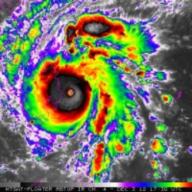如題..
若有... 咁當颱風由南半球踏入北半球個一剎那... 颱風的轉動方向會變成點GA?.. 由順時針即刻變到逆時針???
定係個風會消失左?? OR 颱風跨越南北半球的情況根本冇可能發生??
我真係好想知... PLX!!
有颱風會由南半球跨越北半球嗎??
2007-01-17 10:18 am
回答 (3)
2007-01-18 3:13 am
類似的是有一個, 就是2004年11月生於北印度洋的熱帶氣旋Agni
2004年11月28日在北印度洋的熱帶氣旋Agni,其生成位置是北緯 0.7度,中心離赤道僅70公里,打破了2001年畫眉在新加坡近海北緯1.5度生成的歷史紀錄。比畫眉更驚奇的是,Agni的系統半徑明顯比畫眉為大,外觀上和一般熱帶氣旋無異,但實際上它有大部份的環流是橫跨南北半球的。若根據QuikScat海平面風場分析則更加發現,Agni初生成時的中心曾位於赤道以南,但其風場結構仍維持逆時針旋轉,事件令人匪夷所思。
熱帶氣旋不能在近赤道生成是因為該區科氏力弱,氣流一般都不能有足夠的偏轉而產生渦旋。Agni在橫跨赤道間仍能維持其逆時針環流可能是和旋衡流 (Cyclostrophic) 理論有關,但至於 Agni 如何產生旋衡流的初始環境? 這仍是一個謎。實有待科學家努力研究,尋找答案。
回顧:
https://metocph.nmci.navy.mil/jtwc/atcr/2004atcr/NWP_IO/StormNWP_IO/IO05.html
路徑圖:
http://weather.unisys.com/hurricane/indian_oc/2004/AGNI/track.gif
https://metocph.nmci.navy.mil/jtwc/atcr/2004atcr/NWP_IO/besttracksNWP_IO/ioBT05.gif
其他圖:
http://www.hkcoc.com/tc_angi.gif
~~~~旋衡流理論~~~~
The Cyclostrophic Wind Equation
http://vortex.plymouth.edu/winds/equation/cyclostr.gif
Cyclostrophic flow is a fairly common flow in the atmosphere. This balance involves two forces in the n equation of motion, those being the following:
The centrifugal force:
http://vortex.plymouth.edu/winds/equation/2.gif
The pressure gradient force:
http://vortex.plymouth.edu/winds/equation/3.gif
With the balance between the pressure gradient force in the n equation of motion and the centrifugal force, this constricts the possible types of flow to two types. The flow can be either cyclonic or anti-cyclonic with a circular motion as a result of the centrifugal force. However, the pressure gradient force always points inward, making the center of circulation an area of low pressure. Since only two forces are considered, there are certain assumptions the also have to be made. The flow must be frictionless, always parallel to the height contours, and the scale of the flow is either small in scale or near the equator, where the coriolis force is essentially zero. The following picture illustrates cyclostrophic flow:
http://vortex.plymouth.edu/winds/anim/cycpic1.gif
http://vortex.plymouth.edu/winds/anim/cycpic2.gif
When we assume that a flow is cyclostrophic in nature, the coriolis force is defined as being zero. Therefore, a method must exist to determine if the coriolis force can be neglected. If the ratio of the centrifugal force to the coriolis force is large, then the cyclostrophic assumption can be made. This ratio, called the Rossby number is defined below:
http://vortex.plymouth.edu/winds/equation/rossby.gif
where:
Ro is the Rossby number
There are some real world applications to cyclostrophic flow. Small scale circulations, such as tornados, waterspouts, and dust devils are small enough so that the coriolis force can be neglected. However, tornados typically have a cyclonic circulation associated with them, because the rotation of the mesocyclone that spawns the tornado is cyclonic. However, waterspouts and dust devils are not as constrained to the weather systems that spawn them. Both of these circulations have been observed to be both cyclonic and anti-cyclonic.
2004年11月28日在北印度洋的熱帶氣旋Agni,其生成位置是北緯 0.7度,中心離赤道僅70公里,打破了2001年畫眉在新加坡近海北緯1.5度生成的歷史紀錄。比畫眉更驚奇的是,Agni的系統半徑明顯比畫眉為大,外觀上和一般熱帶氣旋無異,但實際上它有大部份的環流是橫跨南北半球的。若根據QuikScat海平面風場分析則更加發現,Agni初生成時的中心曾位於赤道以南,但其風場結構仍維持逆時針旋轉,事件令人匪夷所思。
熱帶氣旋不能在近赤道生成是因為該區科氏力弱,氣流一般都不能有足夠的偏轉而產生渦旋。Agni在橫跨赤道間仍能維持其逆時針環流可能是和旋衡流 (Cyclostrophic) 理論有關,但至於 Agni 如何產生旋衡流的初始環境? 這仍是一個謎。實有待科學家努力研究,尋找答案。
回顧:
https://metocph.nmci.navy.mil/jtwc/atcr/2004atcr/NWP_IO/StormNWP_IO/IO05.html
路徑圖:
http://weather.unisys.com/hurricane/indian_oc/2004/AGNI/track.gif
https://metocph.nmci.navy.mil/jtwc/atcr/2004atcr/NWP_IO/besttracksNWP_IO/ioBT05.gif
其他圖:
http://www.hkcoc.com/tc_angi.gif
~~~~旋衡流理論~~~~
The Cyclostrophic Wind Equation
http://vortex.plymouth.edu/winds/equation/cyclostr.gif
Cyclostrophic flow is a fairly common flow in the atmosphere. This balance involves two forces in the n equation of motion, those being the following:
The centrifugal force:
http://vortex.plymouth.edu/winds/equation/2.gif
The pressure gradient force:
http://vortex.plymouth.edu/winds/equation/3.gif
With the balance between the pressure gradient force in the n equation of motion and the centrifugal force, this constricts the possible types of flow to two types. The flow can be either cyclonic or anti-cyclonic with a circular motion as a result of the centrifugal force. However, the pressure gradient force always points inward, making the center of circulation an area of low pressure. Since only two forces are considered, there are certain assumptions the also have to be made. The flow must be frictionless, always parallel to the height contours, and the scale of the flow is either small in scale or near the equator, where the coriolis force is essentially zero. The following picture illustrates cyclostrophic flow:
http://vortex.plymouth.edu/winds/anim/cycpic1.gif
http://vortex.plymouth.edu/winds/anim/cycpic2.gif
When we assume that a flow is cyclostrophic in nature, the coriolis force is defined as being zero. Therefore, a method must exist to determine if the coriolis force can be neglected. If the ratio of the centrifugal force to the coriolis force is large, then the cyclostrophic assumption can be made. This ratio, called the Rossby number is defined below:
http://vortex.plymouth.edu/winds/equation/rossby.gif
where:
Ro is the Rossby number
There are some real world applications to cyclostrophic flow. Small scale circulations, such as tornados, waterspouts, and dust devils are small enough so that the coriolis force can be neglected. However, tornados typically have a cyclonic circulation associated with them, because the rotation of the mesocyclone that spawns the tornado is cyclonic. However, waterspouts and dust devils are not as constrained to the weather systems that spawn them. Both of these circulations have been observed to be both cyclonic and anti-cyclonic.
參考: unisys, vortex, jtwc, hkcoc
2007-01-18 1:25 am
我未聽過颱風橫越赤道的事件,因為颱風橫越赤道時就改變了旋轉的方向,導致颱風消散。但都有可能會有颱風橫越赤道的事件發生過。
2007-01-17 10:34 am
未聽聞過會發生。
因為缺乏地轉偏移力,熱帶氣旋在赤道附近很少生成。通常最少在5度以上才有熱帶氣旋生成 ,而且移動方向只會趨向兩極,很少會向赤道走。跨越北半球的熱帶氣旋未有聽聞。
因為缺乏地轉偏移力,熱帶氣旋在赤道附近很少生成。通常最少在5度以上才有熱帶氣旋生成 ,而且移動方向只會趨向兩極,很少會向赤道走。跨越北半球的熱帶氣旋未有聽聞。
收錄日期: 2021-04-25 19:33:06
原文連結 [永久失效]:
https://hk.answers.yahoo.com/question/index?qid=20070117000051KK00316


